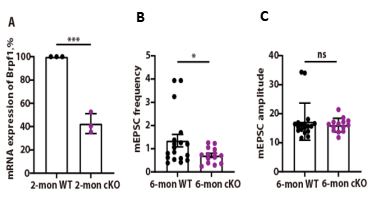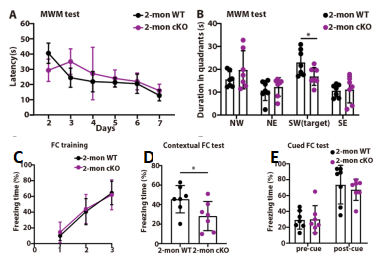NRR:复旦大学基础医学院尤琳雅团队发现前脑兴奋性神经元特异性 Brpf1 缺失可损害空间和恐惧记忆
撰文:赵百成,张航,刘影,尤琳雅
溴结构域和植物同源域PHD含指蛋白1(Brpf1)是一种支架蛋白,是与单核细胞白血病锌指蛋白(MOZ 或 KAT6A)、单核细胞白血病锌MOZ 相关因子(MORF 或 KAT6B)或与起源识别复合物亚基 1(ORC1(HBO1 或 KAT7))结合的跨膜丝氨酸蛋白酶 11DHAT 和2个小的非催化蛋白、生长抑制剂 5 (ING5) 或 ING4 和 MYST/Esa1 相关因子 6 (MEAF6)的四聚体复合物的激活剂[1]。其中3个亚基,即BRPF1、赖氨酸乙酰转移酶6A(KAT6A)和赖氨酸乙酰转移酶6B(KAT6B),已被确定为与显示智力障碍的神经发育障碍相关的种系突变形式的致病基因[2]。到目前为止,在一种被称为智力发育障碍伴畸形面容和上睑下垂的疾病中,已报道了43例患者,共30种BRPF1突变体[3-11];在神经发育障碍中,已发现89例患者,共75种KAT6A变体,智力障碍为100%[12-21]。此外,在Say-Barber-Biesecker-Young-Simpson综合征(SBBYSS或Ohdo综合征)和Genitopatellar综合征患者中也报道了60多种KAT6B变异体[22],这2种疾病也表现为智力障碍。
近期,尤琳雅等在《中国神经再生研究(英文版)》(Neural Regeneration Research)上发表了题为“Forebrain excitatory neuron-specific loss of Brpf1 attenuates excitatory synaptic transmission and impairs spatial and fear memory”的研究,利用急性膜片钳测定微型兴奋性突触后微电流,并对行为学进行测试,包括Morris水迷宫、条件恐惧、新物体识别、三箱社交测试、重复自我梳理以及旷场实验以及RNA测序,了解CaMKIIa-Cre介导的前脑特异性Brpf1敲除对不同年龄小鼠电生理、行为学和分子层面的影响。结果表明前脑兴奋性神经元特异性 Brpf1 缺失可导致微型兴奋性突触后微电流频率降低,空间记忆和场景相关恐惧记忆受损以及相关基因表达失调(如与免疫相关的信号通路下调以及对突触和记忆至关重要的基因Pcdhgb1,Slc16a7,Robo3 和 Rho)。该研究结果有助于解释在BRPF1突变的患者中发生的高渗透性症状--智力障碍。
尤琳雅等以往的研究表明,前脑特异性Brpf1缺失会导致早期致死性的新皮质缺陷、海马和胼胝体发育不全[23, 24],且有研究显示Brpf1表达与人海马体积呈正相关[7]。因此在此次研究中假设Brpf1在产后前脑兴奋性神经元的功能中能起到关键的作用—Brpf1缺乏会导致学习和记忆缺陷,并最终出现智力残疾。为验证这一假设,尤琳雅等使用CaMKIIa-Cre对小鼠模型行前脑兴奋性神经元特异性Brpf1敲除,并采用急性膜片钳技术测量微型兴奋性突触后微电流,并以RNA测序进行验证和分析,再进行包括旷场实验、莫里斯水迷宫、条件恐惧实验、新事物识别以及三箱社交实验等行为学实验进行检测,分别在电活动、分子、行为层面全面了解Brpf1缺失对前脑兴奋性神经元的影响。
在2个月龄的小鼠中,海马的基因敲除效率达到了60%左右(图1A),尤琳雅等既往研究表明,Brpf1敲除后,原代培养的海马神经元的兴奋性突触传递减少[25]。为在体内保留细胞结构和突触回路的情况下确认这种影响,此次实验在6月龄野生型和条件性敲除小鼠脑片中对CA1锥体神经元进行了全细胞膜片钳记录,结果表明Brpf1敲除后,微型兴奋性突触后微电流的频率显著降低(图1B),但振幅变化接近(图1C)。这表明CA1锥体细胞中Brpf1条件性缺失损害了自发的微型兴奋性突触传递。

图1前脑特异性敲除Brpf1可导致微型兴奋性突触后微电流频率下降(图源:Zhao et al., Neural Regen Res, 2024)
BRPF1单基因突变患者的主要临床病症是智力迟钝,而智力迟钝的主要症状之一是学习和记忆功能受损。为验证特异性敲除海马Brpf1对学习和记忆功能的影响,实验7对2月龄的野生型和条件性敲除小鼠进行Morris水迷宫实验、条件恐惧实验、旷场实验、新物体识别实验、三箱社交实验等一系列与认知和记忆功能相关的一系列经典行为学测试。在Morris水迷宫空间记忆测试中,小鼠被训练了7d,并在第8天进行了探测试验。尽管在7d的训练期间,与野生型小鼠相比,条件性敲除小鼠在寻找平台的潜伏期上没有明显的差异(图2A),但在第8天,它们在目标象限的停留时间明显短于野生型小鼠(图2B)。在目标象限花费的时间从23.04s明显减少到16.89s,表明2月龄的海马Brpf1条件性敲除小鼠的空间记忆能力明显受损。为评估条件性敲除小鼠的恐惧表现,即涉及海马、皮层和杏仁核回路的复杂行为[26, 27],实验对另一批的7对2月龄野生型和条件性敲除小鼠进行条件训练、环境关联和声音信号关联。在恐惧记忆学习的第1天,随着声电刺激数量的增加,2种基因型的2月龄小鼠定住不动的时间均有增加的趋势,这表明2组小鼠都获得了与声电刺激相关的恐惧记忆(图2C)。在第2天的场景恐惧记忆测试中,与野生型小鼠相比,2月龄条件性敲除小鼠表现出明显较短的不动的时间(图2D),表明环境性恐惧记忆的损害。然而,对于声音条件性恐惧记忆测试,野生型和条件性敲除小鼠在适应阶段的前3min(提示前)和声音刺激的过程中(提示后)都没有明显的差异(图2E),表明对2月龄条件性敲除小鼠的暗示性恐惧记忆形成没有什么影响。

图2前脑特异性敲除Brpf1可导致空间和恐惧记忆的损害(图源:Zhao et al., Neural Regen Res, 2024)
到目前为止,已经有43例BRPF1突变的报道,证实了BRPF1在智力障碍中的因果作用。其中一个是孤独症患者[2]。因此尤琳雅等研究了类似孤独症的行为,包括通过三箱社交实验测试的交际能力,通过新物体识别的认知能力,通过自我梳理的重复行为以及通过旷场测试的运动活动。三箱社交实验是一种典型的社交能力测试[26]。在2月龄和6月龄的2组小鼠中,与新小鼠(陌生人)在室中花费的时间分别比与空室花费的时间多(图3A和B)。认知能力是通过新物体识别来判断的。条件性敲除小鼠的辨别率与野生型小鼠相似,表明对新颖物体的偏好和对熟悉物体的记忆相似(图3C)。此外,条件性敲除小鼠探索新物体的次数与野生型小鼠没有明显的不同(图3D)。因此,条件性敲除小鼠对探索新奇和熟悉物体的记忆能力影响不大。此外,自我梳理是对孤独症样重复行为的一种有价值的测量方法[27]。在自我梳理实验中没有观察到重复行为的明显差异,表明条件性敲除小鼠对孤独症样重复行为的影响不大(图3E)。最后,实验还测试了前脑特异性敲除Brpf1是否会影响运动活动的旷场实验。在6个时间点中,条件性敲除小鼠的行走距离与野生型小鼠无明显差异(图3F)。条件性敲除小鼠的总行走距离和平均运动速度与野生型小鼠相似(图3G和H)。上述结果表明,前脑特异性敲除Brpf1并不影响社交能力、新物体识别能力、重复行为和运动活动。

图3前脑特异性敲除Brpf1可导致空间和恐惧记忆的损害(图源:Zhao et al., Neural Regen Res, 2024)
为研究前脑特异性敲除Brpf1后兴奋性突触传递减少、空间记忆和恐惧记忆受损的分子机制,尤琳雅等从2月龄小鼠的4对野生型和条件性敲除海马CA1区组织中提取总RNA进行mRNA测序分析,并对177种上调的基因和433种下调的基因进行了GO-BP分析(图4A)。GO-BP结果显示,上调的基因主要参与Wnt信号通路和转录调控,而下调的基因主要参与一氧化氮生物合成过程的调控和免疫反应(图4B)。为探索与微型兴奋性突触后微电流频率降低和空间记忆和恐惧记忆受损相关的机制,实验仔细研究了433种下调的差异表达基因,发现其中16种基因与神经发育、轴突引导、突触和记忆密切相关。继而从这16种基因中选出10种,连同其他下调和上调的差异表达基因,用3对2月龄的野生型和条件性敲除小鼠通过反转录定量PCR验证,结果可见,与神经发育、突触和记忆有关的protocadherin gamma亚家族B 1(Pcdhgb1)、溶质载体家族16成员7(Slc16a7)、迂回引导受体3(Robo3)和Rhodopsin(Rho)都出现明显下调(图4C)。这表明Brpf1作为一种激活剂,可促进与海马的神经发育、突触和记忆相关的一系列基因的表达。而验证上调的基因中,与Wnt信号通路相关的配对的homeodomain 2(Pitx2)和腹前homeobox 2(Vax2)被明显上调。此外,在正常大脑中应该被抑制的转录因子T细胞白血病homeobox 1(Tlx1)、paired box 2(Pax2)、Pax1、twist家族BHLH转录因子1(Twist1)和POU class 4 homeobox 2(Pou4f2)被异常地上调了。这表明Brpf1也作为一种抑制剂抑制了这些基因的表达,包括Wnt信号基因、Hox基因和其他转录因子在海马的表达(图4D)。

图4前脑特异性敲除Brpf1可导致相关的基因表达失调(图源:Zhao et al., Neural Regen Res, 2024)
尤琳雅等通过CaMKIIa-Cre进行基因敲低,确定了基因Brpf1在出生后小鼠的海马功能中的重要作用。该研究结果显示,海马兴奋性神经元特异性的Brpf1缺失能够导致电生理中微型兴奋性突触后微电流频率降低,小鼠本身的空间记忆和恐惧记忆受损。进一步探究发现,Brpf1敲低还可导致Pcdhgb1,Slc16a7,Robo3和Rho等基因表达失常,而这些基因对突触和记忆至关重要。且Brpf1许多炎症相关通路的下调作用暗示了神经炎症作为病理机制的可能性。
既往研究已发现,全脑Brpf1敲除小鼠在E9.5时死亡,前脑特异性Brpf1敲除小鼠在出生后2-3周左右死亡[23, 24],因此无法进行进一步的行为评估。因此尤琳雅等使用CaMKIIa-Cre对海马和大脑皮质中的Brpf1进行特异性敲除,且这些小鼠基本能存活到成年期,这使得能够通过一系列行为任务来评估Brpf1缺失对海马CA1锥体神经元的具体影响。
尤琳雅等在实验中发现了许多有趣的现象:在电生理中,微型兴奋性突触后微电流频率的变化通常表明突触前释放概率的改变,而微型兴奋性突触后微电流振幅的变化往往表明突触后受体功能或/和数量的变化。这一结果说明,Brpf1敲低改变的应该是突触前的结构;有趣的是,通过RNA测序以及反转录定量PCR验证的Robo3、Pcdhgb1和Vdr等下调基因,与这种假设不谋而合。Robo3缺失可导致异位突触形成,神经递质释放减少,可快速释放的突触囊泡减少[28];Pcdhgb1是可以控制突触发生的基因[29];室旁下丘脑部位的Vdr缺失可导致微型兴奋性突触后微电流受损[30]。
实验结果显示在“场景条件恐惧试验”和“线索条件恐惧试验”中,小鼠的不定时间(代表恐惧状态)有所差异。尤琳雅等认为这2种测试激活的脑区不完全相同:“场景条件恐惧试验”更多地依赖于海马体和其他与空间信息处理相关的脑区[31];而“线索条件恐惧试验”更多地依赖于杏仁核和其他与情绪记忆和联想学习相关的脑区[32]。这侧面验证并解释了作者对海马Brpf1的特异性敲除是有效的。
GO-BP分析显示,炎症和免疫反应相关的信号通路受到了Brpf1基因的影响,这使得尤琳雅等想到神经炎症和学习记忆能力的关系。已有研究表明,Brpf1能够影响中性粒细胞趋化和NF-κB通路,但这些通路与神经元和突触发育异常、脑容量减少、认知和行为异常,以及情绪和心理健康问题相关[33]。慢性神经炎症可导致神经元功能和结构的改变,从而影响神经可塑性和认知功能。
基于这些发现,尤琳雅等提出了Brpf1调节海马基因表达中的双重作用模型:首先,Brpf1可能通过Kat6a/Kat6b作为激活因子,促进海马体神经发育、突触和记忆相关基因的表达;此外,Brpf1还可能通过Kat7抑制海马中Wnt信号基因和Hox基因等转录因子的表达。
尽管有许多有趣的发现,但该研究仍有有待改进的地方:第一,行为学试验中使用的样本量相对不足;第二,行为学试验中使用的动物的年龄并不一致;第三,基因敲除效率只有60%左右;第四,没有对参与水迷宫的小鼠进行视力测试,无法排除视觉能力对水迷宫结果的影响;第五,应该测定更多的电生理指标,以对结果进行更全面的分析。
原文链接:https://doi.org/10.4103/1673-5374.385307
参考文献:
[1] Ullah M, Pelletier N, Xiao L, et al. Molecular architecture of quartet MOZ/MORF histone acetyltransferase complexes. Mol Cell Biol. 2008;28(22):6828-6843.
[2] Zu G, Liu Y, Cao J, et al. BRPF1-KAT6A/KAT6B Complex: Molecular Structure, Biological Function and Human Disease. Cancers (Basel). 2022;14(17):4068.
[3] Yan K, Rousseau J, Machol K, et al. Deficient histone H3 propionylation by BRPF1-KAT6 complexes in neurodevelopmental disorders and cancer. Sci Adv. 2020;6(4):eaax0021.
[4] Yan K, Rousseau J, Littlejohn RO, et al. Mutations in the Chromatin Regulator Gene BRPF1 Cause Syndromic Intellectual Disability and Deficient Histone Acetylation. Am J Hum Genet. 2017;100(1):91-104.
[5] Mattioli F, Schaefer E, Magee A, et al. Mutations in Histone Acetylase Modifier BRPF1 Cause an Autosomal-Dominant Form of Intellectual Disability with Associated Ptosis. Am J Hum Genet. 2017;100(1):105-116.
[6] Souza J, Do Valle DA, Santos M, et al. BRPF1-associated syndrome: A patient with congenital ptosis, neurological findings, and normal intellectual development. Am J Med Genet A. 2022;188(6):1875-1880.
[7] Zhao L, Yang X, Cui L, et al. Increased expression of a novel miRNA in peripheral blood is negatively correlated with hippocampal volume in patients with major depressive disorder. J Affect Disord. 2019;245:205-212.
[8] Naseer MI, Abdulkareem AA, Guzmán-Vega FJ, et al. Novel Missense Variant in Heterozygous State in the BRPF1 Gene Leading to Intellectual Developmental Disorder With Dysmorphic Facies and Ptosis. Front Genet. 2020;11:368.
[9] Pode-Shakked N, Barel O, Pode-Shakked B, et al. BRPF1-associated intellectual disability, ptosis, and facial dysmorphism in a multiplex family. Mol Genet Genomic Med. 2019;7(6):e665.
[10] Keywan C, Holm IA, Poduri A, et al. A de novo BRPF1 variant in a case of Sudden Unexplained Death in Childhood. Eur J Med Genet. 2020;63(9):104002.
[11] Xu B, Roos JL, Dexheimer P, et al. Exome sequencing supports a de novo mutational paradigm for schizophrenia. Nat Genet. 2011;43(9):864-868.
[12] Kennedy J, Goudie D, Blair E, et al. KAT6A Syndrome: genotype-phenotype correlation in 76 patients with pathogenic KAT6A variants. Genet Med. 2019;21(4):850-860.
[13] Alkhateeb A, Alazaizeh W. A Novel De Novo Frameshift Mutation in KAT6A Identified by Whole Exome Sequencing. J Pediatr Genet. 2019;8(1):10-14.
[14] Marji FP, Hall JA, Anstadt E, et al. A Novel Frameshift Mutation in KAT6A Is Associated with Pancraniosynostosis. J Pediatr Genet. 2021;10(1):81-84.
[15] Urreizti R, Lopez-Martin E, Martinez-Monseny A, et al. Five new cases of syndromic intellectual disability due to KAT6A mutations: widening the molecular and clinical spectrum. Orphanet J Rare Dis. 2020;15(1):44.
[16] Lin YF, Lin TC, Kirby R, et al. Diagnosis of Arboleda-Tham syndrome by whole genome sequencing in an Asian boy with severe developmental delay. Mol Genet Metab Rep. 2020;25:100686.
[17] Bae S, Yang A, Kim J, et al. Identification of a novel KAT6A variant in an infant presenting with facial dysmorphism and developmental delay: a case report and literature review. BMC Med Genomics. 2021;14(1):297.
[18] Korakavi N, Bupp C, Grysko B, et al. First case of pan-suture craniosynostosis due to de novo mosaic KAT6A mutation. Childs Nerv Syst. 2022;38(1):173-177.
[19] Efthymiou S, Salpietro V, Bettencourt C, et al. Paroxysmal Movement Disorder and Epilepsy Caused by a De Novo Truncating Mutation in KAT6A. J Pediatr Genet. 2018;7(3):114-116.
[20] Jiang M, Yang L, Wu J, et al. A de novo heterozygous variant in KAT6A is associated with a newly named neurodevelopmental disorder Arboleda-Tham syndrome-a case report. Transl Pediatr. 2021;10(6):1748-1754.
[21] Trinh J, Hüning I, Yüksel Z, et al. A KAT6A variant in a family with autosomal dominantly inherited microcephaly and developmental delay. J Hum Genet. 2018;63(9):997-1001.
[22] Brea-Fernández A, Dacruz D, Eirís J, et al. Novel truncating variants expand the phenotypic spectrum of KAT6B-related disorders. Am J Med Genet A. 2019;179(2):290-294.
[23] You L, Zou J, Zhao H, et al. Deficiency of the chromatin regulator BRPF1 causes abnormal brain development. J Biol Chem. 2015;290(11):7114-7129.
[24] You L, Yan K, Zou J, et al. The lysine acetyltransferase activator Brpf1 governs dentate gyrus development through neural stem cells and progenitors. PLoS Genet. 2015;11(3):e1005034.
[25] Xian W, Cao J, Yuan X, et al. Deficiency of Intellectual Disability-Related Gene Brpf1 Attenuated Hippocampal Excitatory Synaptic Transmission and Impaired Spatial Learning and Memory Ability. Front Cell Dev Biol. 2021;9:711792.
[26] Gompers AL, Su-Feher L, Ellegood J, et al. Germline Chd8 haploinsufficiency alters brain development in mouse. Nat Neurosci. 2017;20(8):1062-1073.
[27] Ellegood J, Petkova SP, Kinman A, et al. Neuroanatomy and behavior in mice with a haploinsufficiency of AT-rich interactive domain 1B (ARID1B) throughout development. Mol Autism. 2021;12(1):25.
[28] Michalski N, Babai N, Renier N, et al. Robo3-driven axon midline crossing conditions functional maturation of a large commissural synapse. Neuron. 2013;78(5):855-868.
[29] Garrett AM, Weiner JA. Control of CNS synapse development by {gamma}-protocadherin-mediated astrocyte-neuron contact. J Neurosci. 2009;29(38):11723-11731.
[30] Beck J, Da Silva Teixeira S, Harrison K, et al. Paraventricular Vitamin D Receptors Are Required for Glucose Tolerance in Males but Not Females. Front Endocrinol (Lausanne). 2022;13:869678.
[31] Li WG, Wu YJ, Gu X, et al. Input associativity underlies fear memory renewal. Natl Sci Rev. 2021;8(9):nwab004.
[32] Kellis DM, Kaigler KF, Witherspoon E, et al. Cholinergic neurotransmission in the basolateral amygdala during cued fear extinction. Neurobiol Stress. 2020;13:100279.
[33] Hagberg H, Gressens P, Mallard C. Inflammation during fetal and neonatal life: implications for neurologic and neuropsychiatric disease in children and adults. Ann Neurol. 2012;71(4):444-457.



